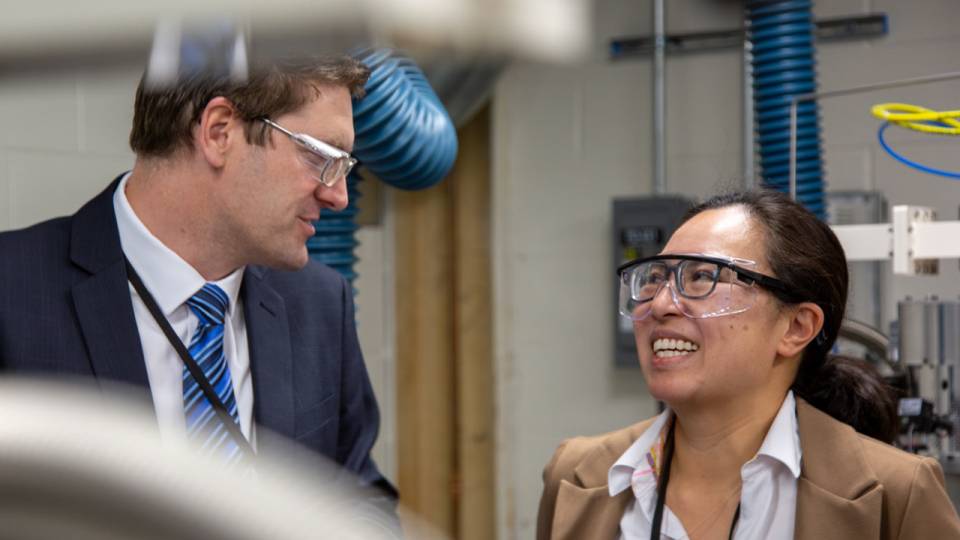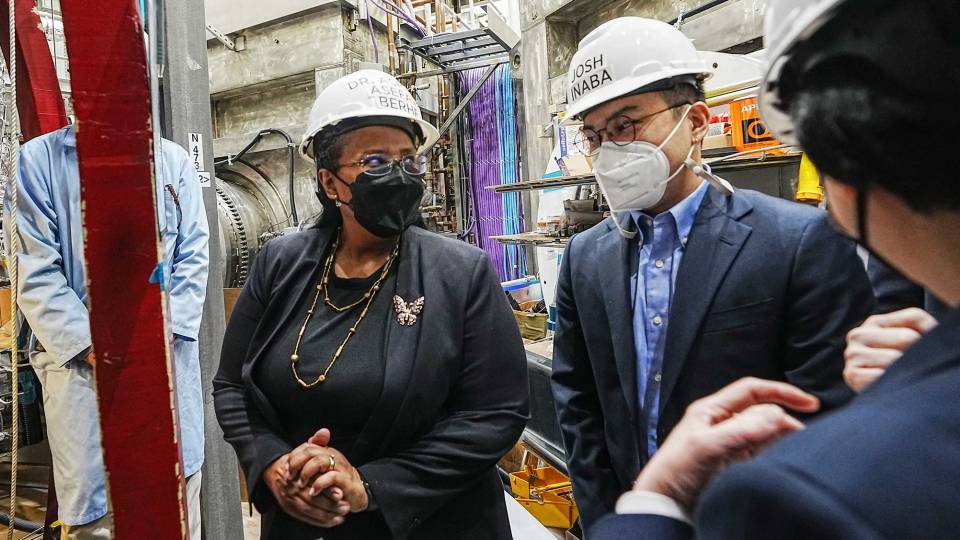Lessening the effects of climate change will require a variety of innovations and a lot of ingenuity. Now, a new center led by the U.S. Department of Energy’s (DOE) Princeton Plasma Physics Laboratory(Link is external) (PPPL), managed by Princeton University, will help these efforts by advancing the understanding of plasma-based clean hydrogen production.
PPPL was selected to lead a DOE Energy Earthshot Research Center (EERC) as part of the Hydrogen Shot(Link is external) (Link opens in new window), which aims to reduce the cost of hydrogen by 80%. With funding from the DOE’s Office of Science, the EERCs support fundamental research to accelerate breakthroughs in support of the Energy Earthshots Initiative(Link is external) (Link opens in new window), which brings together scientists to help achieve and advance national climate and economic competitiveness goals.

Yiguang Ju
The award provides $5 million over four years to study the use of plasma — the electrically charged fourth state of matter that makes up 99% of the visible universe — to produce hydrogen, a carbon-free fuel and a common feedstock used in chemicals and materials manufacturing. Yiguang Ju(Link is external) (Link opens in new window), a PPPL managing principal research physicist and the Robert Porter Patterson Professor of Mechanical and Aerospace Engineering(Link is external) (Link opens in new window) at Princeton University, will head the EERC at PPPL.
The center is part of the laboratory’s efforts to diversify its research. While PPPL remains a world leader in the science and engineering behind the development of fusion, it is now using its expertise in low-temperature plasmas to advance low-carbon-emission technologies for a sustainable and competitive U.S. manufacturing industry.
Described by PPPL researchers as “electromanufacturing,” this emerging field of research investigates ways to replace the energy provided by fossil fuels with clean electricity, including using plasmas in several industrial processes. The new branch of work is housed within the larger Applied Materials and Sustainability Sciences(Link is external) (AMSS) directorate, which is led by Emily A. Carter(Link is external), senior strategic advisor and associate laboratory director for AMSS at PPPL.
“The Energy Earthshot idea is a variation of the moonshot effort of the 1960s in that the country is mobilizing to accomplish the grand goal of producing massive quantities of clean energy,” said Carter, who is also the Gerhard R. Andlinger Professor in Energy and the Environment; professor of mechanical and aerospace engineering, the Andlinger Center for Energy and the Environment, and applied and computational mathematics at Princeton University.
“For 70 years, PPPL has been known as the place to go for fusion research, and we still are,” she said. “But a few years ago, PPPL scientists realized that the lab’s expertise could also help improve many industrial processes that involve plasma. Producing hydrogen can be one of those.”
Seeking a paradigm shift in clean hydrogen production
The EERC will be known as the Center for the Science of Plasma-Enhanced Hydrogen Production (PEHPr), and experiments will be conducted at both PPPL and Princeton University. The center will explore using catalysts and plasma, ultimately created with renewable electricity, to produce hydrogen.
The plasma technique could replace current methods of synthesizing hydrogen molecules, which mostly rely on steam reforming of natural gas, which emits large amounts of carbon dioxide. The researchers use a process called methane pyrolysis to produce a solid carbon, which effectively stores the carbon. They also use a process called “dry reforming” to reform methane into synthesis gas.
“You can get higher temperatures from the hot electrons in a plasma than from today’s technique of burning methane,” Ju said. “That allows us to potentially produce hydrogen more efficiently and for a lower cost without producing carbon emissions.”
The work could lead to a paradigm shift in clean hydrogen production by bringing forth energy-efficient, plasma-mediated catalytic processes for low-cost, electrified hydrogen gas production.
Training future world leaders in green energy production
Part of the center’s efforts will also include educating the public about their findings and attracting new researchers to the field. “We have a great team, and we’re excited for this opportunity to work on such a significant project. We plan to work on encouraging high school and college students to apply for hydrogen-related summer internships to help train the world’s future leaders in green energy production,” Ju said. “We will also organize workshops and summer schools to disseminate our findings to industry and the public.”
If the DOE’s Hydrogen Shot™ goals are achieved, scenarios show the opportunity for at least a five-fold increase in clean hydrogen use. A U.S. industry estimate shows the potential for 16% carbon dioxide emission reduction by 2050 as well as $140 billion in revenues and 700,000 jobs by 2030. Achieving the Hydrogen Shot™’s 80% cost reduction goal could also unlock new markets for hydrogen, including steel manufacturing, clean ammonia, energy storage, and heavy-duty trucks.
In addition to the Hydrogen Shot™, PPPL will receive $1 million to collaborate with another EERC led by Oak Ridge National Laboratory. This center will be part of the larger Industrial Heat Shot(Link is external) (Link opens in new window), which focuses on using clean electricity instead of fossil fuels to produce the heat needed for many industrial processes.
The other Energy Earthshots include the Long Duration Storage Shot(Link is external) (Link opens in new window), the Carbon Negative Shot(Link is external) (Link opens in new window), the Enhanced Geothermal Shot(Link is external) (Link opens in new window), the Floating Offshore Wind Shot(Link is external) (Link opens in new window), and the Clean Fuels & Products Shot(Link is external) (Link opens in new window).
For more information about the winners, see the DOE announcement(Link is external) (Link opens in new window).
PPPL, on Princeton University’s Forrestal Campus in Plainsboro, N.J., is devoted to creating new knowledge about the physics of plasmas — ultra-hot, charged gases — and to developing practical solutions for the creation of fusion energy. The Laboratory is managed by the University for the U.S. Department of Energy’s Office of Science, which is the single largest supporter of basic research in the physical sciences in the United States and is working to address some of the most pressing challenges of our time. For more information, visit https://energy.gov/science(Link is external) (Link opens in new window).






